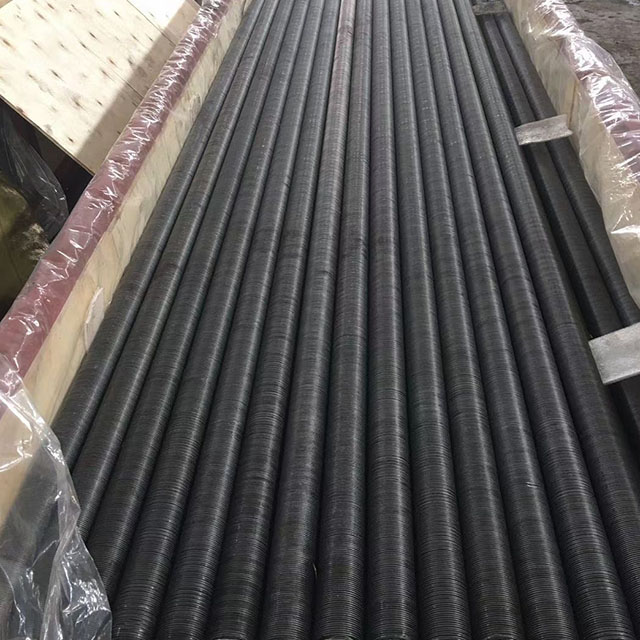Product Overview
The High-Surface Fin Heat Tube amplifies thermal transfer efficiency through engineered finned surfaces that expand effective heat exchange area by 3-8 times compared to smooth tubes—addressing the low heat transfer coefficient of air (a common challenge in air-cooled systems). Designed exclusively for air-cooled or gas-side heat transfer applications (e.g., condensers, radiators), it integrates aluminum (lightweight, high conductivity) or copper (higher conductivity, heavier) fins with a base tube (carbon steel, 304/316 stainless steel, or copper) and meets ANSI/ASME B31.1 standards (for power piping) and ASHRAE 90.1 energy efficiency guidelines. Fin densities range from 10 to 40 fins per inch (fpi)—low density (10-15 fpi) for high-airflow environments (e.g., outdoor radiators), high density (30-40 fpi) for low-airflow spaces (e.g., indoor HVAC units).

Product Features
Fin Geometry Optimization: Choice of three fin types to match application needs: plain fins (low cost, ideal for clean air), wavy fins (increase air turbulence by 20%, boosting heat transfer), and louvered fins (create vortexes in airflow, boosting efficiency by an additional 15% vs. plain fins). Louvered fins are most common in automotive radiators and HVAC condensers.
Secure Fin Bonding: Two bonding methods ensure long-term fin attachment: brazing (for high-temperature applications, e.g., 300℃+ industrial coolers) and mechanical expansion bonding (tube expansion to press fins onto the base tube, for low-temperature applications like refrigeration). Both methods achieve peel strength of ≥50 psi (tested per ASTM D903), preventing fin detachment (a major cause of efficiency loss).
Aerodynamic Design: Low-profile fins (height 3-15mm) minimize air resistance (pressure drop ≤50 Pa at 2 m/s airflow), reducing fan energy consumption by 10-20% compared to tall-fin designs. This is critical for battery-powered equipment (e.g., EV radiators) where fan power impacts range.
Weather Resistance: Galvanized (zinc-coated) fin coatings provide 1,000+ hours of salt spray resistance (per ASTM B117 testing) for outdoor applications (e.g., rooftop HVAC units). For coastal areas, aluminum fins with chromate conversion coatings offer additional corrosion protection against salt humidity.
Applications
Refrigeration: Condenser coils in walk-in freezers (maintaining -18℃) and supermarket display cases, where high-density (35-40 fpi) louvered fins maximize heat transfer in low-airflow indoor spaces (to avoid freezing product).
Industrial Cooling: Oil coolers for hydraulic systems in manufacturing machinery (e.g., injection molding machines), with copper fins and carbon steel base tubes delivering fast heat dissipation to keep hydraulic oil at 40-60℃ (optimal viscosity range).
Power Electronics: Heat sinks for inverter systems in renewable energy installations (e.g., solar PV inverters, wind turbine converters), where high-power density (100-500 kW) requires efficient heat rejection to avoid component overheating (max safe temp ≤85℃).
HVAC: Air handlers in commercial buildings (e.g., office towers, hospitals), with wavy fins and aluminum base tubes balancing efficiency and weight—reducing duct load and installation costs.
FAQ
Q: Can fins withstand high humidity?
A: Yes, hydrophilic-coated fins (a polymer layer applied to fin surfaces) prevent condensation buildup by spreading water into a thin film (instead of droplets), reducing mold growth and maintaining airflow. These coatings are standard in HVAC units for humid climates (e.g., Florida, Southeast Asia) and last 5-7 years before reapplication.
Q: What fin density is best for low-airflow environments?
A: High-density fins (30-40 fpi) are ideal, as they maximize surface area without excessive airflow restriction. For example, in a compact indoor refrigerated display case (airflow ≤1 m/s), 40 fpi fins increase heat transfer by 35% vs. 15 fpi fins—critical for maintaining set temperatures with small, low-power fans.
Q: How to clean finned surfaces?
A: Use low-pressure compressed air (≤50 psi) to blow away loose dust, or a mild detergent spray (pH 6-8, e.g., dish soap diluted 1:10 with water) for caked-on debris. Avoid high-pressure washing (>100 psi), as it can bend fin louvers or damage bonding—reducing efficiency by 10-15% per cleaning.





















